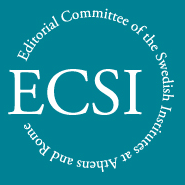Published by the Swedish Institute at Athens. Distributed by Astrom Editions.
The Greek Renaissance of the eight century B.C. Tradition and innovation. Proceedings of the Second International Symposium at the Swedish Institute at Athens
Edited by Robin Hägg
Abstract
”The Greek Renaissance” designates the formative period of the Greek society of historical times during the latter half of the eight century B.C. The 24 papers originally read at a symposium deal with various aspects of this period; they are followed by transcripts of the discussions of the symposium. The contributors are specialists in ancient history, archaeology, philology, epigraphy, art history and history of religion. Among the topics dealt with are historical reasons for the rediscovery of the Mycenaean past in the age of Homer, the regional pottery styles, burial customs and attitudes to death, Oriental traits in epic poetry, the origin and early spread of the alphabet, Late Geometric art, especially vase painting, early Greek religion, especially cult images and altars, the growth of the pan-Hellenic santuaries, diviners and magicians, the working of bronze and ironin sanctuaries, obeloi as pre-monetary currency, the size and growth of populations, Homeric medicine, cult of the ancestors, the symposion as social organization, the customs of gift exchange. Questions dealt with in the discussions concerned continuity versus discontinuity, uniformity versus regional diversity, internal development versus external influences, the meaning of the ‘Renaissance’ and the reasons for its occurrence in the eight century, the social and economic changes in the Greek society connected with the formation of the polis.
Contents
‘Preface’, pp. 7–8.
Stefan Hiller, ’Possible historical reasons for the rediscovery of the Mycenaean past in the age of Homer’, pp. 9–14.
‘Discussion’, p. 15.
J.N. Coldstream, ‘The meaning of the regional styles in the eight century B.C.’, pp. 17–25.
Robin Hägg, ‘Burial customs and social differentiation in 8th-century Argos’, pp. 27–31.
‘Discussion’, p. 31.
Christiane Sourvinou-Inwood, ‘A trauma in flux: Death in the 8th century and after’, pp. 33–48.
‘Discussion’, p. 49.
‘General discussion on history and society’, p. 49.
Walter Burkert, ‘Oriental myth and literature in the Iliad’, pp. 51–56.
‘Discussion’, p. 56.
E. Christan Kopff, ‘The structure of the Amazonia (Aithiopis)’, pp. 57–62.
‘Discussion’, p. 62.
Alan Johnston, ‘The extent and use of literacy: the archaeological evidence’, pp. 63–68.
‘Discussion’, p. 68.
Jan Bouzek, ‘The legacy of Late Geometric art’, pp. 69–73.
Jörg Schäfer, ‘Steps toward representational art in 8th-century vase painting’, pp. 75–81.
‘Discussion’, p. 81.
‘General discussion on art and literature’, p. 82.
B.C. Dietrich, ‘Tradition in Greek religion’, pp. 85–89.
‘Discussion’, p. 90.
Stefan Hiller, ‘Mycenaean traditions in early Greek cult images’, pp. 91–99.
‘Discussion’, p. 99.
David W. Rupp, ‘Reflections on the development of altars in the eight century B.C.’, pp. 101–107.
‘Discussion’, p. 107.
Claude Rolley, ‘Les grand sanctuaires panhelléniques’, pp. 109–114.
‘Discussion’, p. 114.
Walter Burkert, ‘Itinerant diviners and magicians: a neglected element in cultural contacts’, pp. 115–119.
‘Discussion’, p. 120.
‘General discussion on religion and sanctuaries’, p. 120.
Rainer C.S. Felsch, ‘Zur Chronologie und zum Stil geometrischer Bronzen aus Kalapodi’, pp. 123–129.
Klaus Kilian, ‘Weihungen aus Eisen und Eisenverarbeitung im Heiligtum zu Philia (Thessalien)’, pp. 131–146.
‘Discussion’, p. 146.
Paul Courbin, ‘Obéloi d’Argolide et d’ailleurs’, pp. 149–156.
‘Discussion’, p. 156.
Petros G. Themelis, ‘An 8th century goldsmith’s workshop at Eretria’, pp. 157–165.
‘Discussion’, p. 165.
‘General discussion on metal votives and metal working’, p. 165.
A.M. Snodgrass, ‘Two demographic notes’, pp. 167–171.
‘The size of Lefkandi’, p. 167.
‘Population in late eight-century Attica’, p. 169.
Demetrius U. Schilardi, ‘The decline of the Geometric settlement of Koukounaries at Paros’, pp. 173–183.
Hara Tzavella-Evjen, ‘Homeric medicine’, pp. 185–188.
‘Discussion’, p. 188.
Robin Hägg, ‘Funerary meals in the Geometric necropolis at Asine?’, pp. 189–193.
‘Discussion’, p. 193.
Oswyn Murray, ‘The symposion as social organisation’, pp. 195–199.
‘Discussion’, p. 199.
‘General discussion on population and social customs’, p. 200.
J.N. Coldstream, ‘Gift exchange in the eight century B.C.’, pp. 201–206.
‘Discussion’, p. 207.
‘Final general discussion’, pp. 208–212.
‘Programme and participants of the symposium’, pp. 213–214.
‘Abbreviation’, pp. 215–216.
‘Indexes’, pp. 217–225.
Bibliographical information
Robin Hägg, ed., The Greek Renaissance of the eight century B.C. Tradition and innovation. Proceedings of the Second International Symposium at the Swedish Institute at Athens (Skrifter utgivna av Svenska institutet i Athen, 4°, 30), Jonsered 1983. ISSN 0586-0539. ISBN 9789185086580.
Alternative series title:
Acta Instituti Atheniensis Regni Sueciae series in 4˚, XXX

No Comments
Comments are closed.